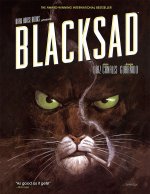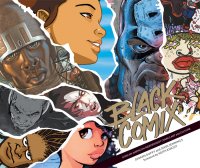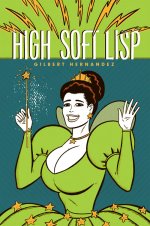|
The Year That Was 2010, Part Two (The Top Half of the Top Ten)
Happy Winter-festing, all. Here's the now traditional Nexus Graphica year-end wrap-up, where Rick and
I present the top half of our "ten best" list for the year. As I've noted before, since reviewing is entirely
subjective, there are doubtless other "bests" out there we've missed -- but we go on what we've read, what's
been sent to us, etc.
And on that note, Rick correctly lauded our differing tastes -- how our lists usually diverge from one another. This
past year, that sense was heightened since we were sent almost entirely different books these past 12 months, rarely
getting the same things from the same publishing houses. So there were fewer chances for our lists to be the same,
even if we'd wanted them to be!
And on that note, may the new year be kind to you and yours, in such unknowable times. But are they ever
knowable? Here's what we know at NG -- here are some comics we liked:

 5.
(Rick)
Wednesday Comics edited by Mark Chiarello (DC)
5.
(Rick)
Wednesday Comics edited by Mark Chiarello (DC)
Throughout the 30s, 40s, and 50s, adventure strips dominated the Sunday newspaper comics pages. Oversized,
full color pages featured the thrilling tales of Prince Valiant, Tarzan,Flash Gordon, and countless
others. Under the guidance of DC art director Mark Chiarello, Wednesday Comics successfully re-captured this
lost era with a series of oversized weeklies à la the Sunday funnies (dubbed Wednesday rather than Sunday in
honor of the day new comics arrive in stores). This beautiful 11"x17" 200-page hardcover volume collects all
the tales from the incredible 12-week run. While each featured A-list talent, some stories work better than
others. Jack Kirby's creation Kamandi: The Last Boy on Earth (expertly rendered by writer Dave Gibbons and
artist Ryan Sook); Paul Pope's unique take on Adam Strange; and especially Hawkman as delightfully envisioned
by Kyle Baker lovingly embracing the format and lessons of their antecedents. Other excellent tales excel under
the contributions of Brian Azzarello, Eduardo Risso, Kurt Busiek, Joe Quiñones, Karl Kerschi, Brenden Fletcher,
Walt Simonson and Brian Stelfreeze. Regardless of the story, one mood permeates the entire volume: fun. Combine
all this with previously unpublished strips starring Plastic Man and Creeper, original sketches, and Chiarello's
impressive book design, and Wednesday Comics quickly emerges as must-experience for all classic comic book fans.
(Mark)
Rabbi Harvey vs. the Wisdom Kid by Steve Sheinkin (Jewish Lights)
(No sooner do I note that we've read different things than I have to point out that I have a big stack of
Wednesday Comics, too. They look really, really good, but I didn't go over them as thoroughly as Rick
did -- yet -- because I was reading other stuff for my own column deadline!)
Meanwhile, longtime NG readers know how much I've already enjoyed Reb Harvey's earlier adventures,
and here Sheinkin's affectionate take on Talmudic and other Jewish folk tales, reworked and re-set in the 19th
century Rockies, continues what is practically an "alternate history," with predominantly Jewish enclaves among
the mining towns of the gold, silver, and fur-boom eras. Disputes are settled not with Colts or Winchesters, but
with parables and reason(!). At least they are while Rabbi Harvey is dispensing advice, Lucy van Pelt-style,
until he is challenged by a young upstart Rebbe, who is a little too glib, and -- yes! -- part of a plan
engineered by his mother, the "Bad Bubbe." What would Philip Roth make of that? For the first time, Sheinkin
gives us a book-length tale -- with the reworked parables and folk tales in service of a larger plot, rather
than the other way 'round. And with his still Sepia-esque, still woodcut-influenced style (makes sense when
the setting is high timber!) the ride -- on a horse, even! -- is every bit as enjoyable in this third volume
as it was last time out.

 4.
(Rick)
Blacksad Written by Díaz Canales, Art by Juanjo Guarnido (Dark Horse)
4.
(Rick)
Blacksad Written by Díaz Canales, Art by Juanjo Guarnido (Dark Horse)
Perhaps the most acclaimed French comic of the new century, Canales and Guarnido cleverly combine the seemingly
disparate elements of anthropomorphic animal and 50s crime fiction into their wholly original
creation, Blacksad. Private eye cat John Blacksad uncovers the often filthy depths of mysteries involving
child abductions, nuclear secrets, racist hate groups, and of course murder. Guarnido evokes the period through
his evocative and elegant art while Canales' script successfully recalls the era's moods and attitudes through
a contemporary lens. One of the best books of the year, Blacksad more than deserves its abundant praise.
(Mark)
Trickster by Matt Dembicki (ed.) and other contributors (Fulcrum)
Tricksters, of course, are those characters who can move between worlds, boundaries, rules, and sometimes
genders, and transform things. Hopefully for the better, but maybe, not always. Here Dembicki has put together
a great introduction to Native American trickster tales, in accessible "graphic novel" versions (novellas?)
for those who have yet to catch up with the adventures of Coyote -- the continent's first media star -- outside
of a Looney Tunes cartoon. The stories don't just stick to the well-known Coyote, and include other trickster
luminaries like Raccoon, Raven, Rabbit, and more. The "tellers" here are Native American storytellers -- each
paired with a stylistically different artist (from "serious" painted work to exaggerated cartooning) -- which
means that the story structures, often defying Western expectations of "linearity" (and cause and effect),
are preserved. Not that a real trickster worries, particularly, about structure. Or form.

 3.
(Rick)
It Was The War of the Trenches by Jacques Tardi (Fantagraphics)
3.
(Rick)
It Was The War of the Trenches by Jacques Tardi (Fantagraphics)
This extraordinary collection of World War I tales offers perhaps the finest work from the lauded Tardi. Each
story, based on actual accounts from French soldiers, relates the often-horrific realities of
trench-warfare. Disturbing yet compelling images abound: a dead, mangled horse hanging from a tree serves as a
warning; rats feasting on corpses; amputations; executions; countless dead. Far more memorable are the
impassioned stories themselves. Betrayal, deceit, mistrust, murder, hope, and even humor run throughout
these tales. Painstakingly researched, the amazing Tardi perfectly captures the everyday despair of the
World War I trench soldier. Visceral, powerful, and effective, the flawless It Was The War of the Trenches
blazes a new standard for the war comic.
(Mark)
X'ed Out by Charles Burns (Pantheon)
This is the only book on my list that Rick reviewed and I didn't write about in the "regular" column. In
fairness to his Tardi pick, that's been on my desk waiting for a thorough read as well, though Rick wrote it
up first. I picked up the Burns on recent winter night, before we knew which of us would review it, intrigued
by its surreal TinTin feel. Rick's line that the work is "equal parts Hergé and William Burroughs" is right
on the money, as we follow our hero Doug through an initial hole-in-the-wall, and various holes in his
existence (and the world's at large), as he winds up in various parallel/overlapping dimensions, city-scapes,
etc. Not entirely unlike the film Inception, in asserting that even the most grounded "reality"... may not
be. I need to re-read this a few more times, but I loved the use of color and "coffee table comic" tropes
to explode the form, and the keep the ground shaky underneath my visual feet. And really, a phrase
like "visual feet" is entirely in context here.

 2.
(Rick)
Black Comix: African American Independent Comics Art and Culture by Damian Duffy & John Jennings (Mark Batty)
2.
(Rick)
Black Comix: African American Independent Comics Art and Culture by Damian Duffy & John Jennings (Mark Batty)
Duffy and Jenning's beautiful survey chronicles the under-publicized culture of the African American
comic. Illustrated with an abundance of magnificent color and black & white art from the finest African American
artists of the past 25 years, the book intersperses revealing essays pertaining to various aspects of the
culture including a retrospective of Brotherman, and explorations of hip-hop, humor, superheroes, criticism,
conventions, awards, and other topics. From Shawn Alleyne
(Hero's Diary) to Ashely A. Woods (Millennia War),
Black Comix showcase alphabetically over fifty artists. Outside of industry vets such Larry
Stroman (X-Factor, Alien Legion), and Eric
Battle (Batman, Green Arrow, Spider-Man), a vast majority of
these talented creators will be unknown except to the most ardent fan. Hopefully, the gorgeous volume, a
must have for any serious fan of the medium, will alleviate these oversights.
(Mark)
YUMMY The Last Days of a Southside Shorty by G. Neri (writer) and Randy DuBurke (art) (Lee & Low Books)
Multicultural kid-lit publisher Lee & Low jump in to the graphic novel arena with a haunting tale about
death and desertion on Chicago's South Side -- haunting, because it's all true. 11 year-old
Robert "Yummy" Sandifer -- so nicknamed because of his sweet tooth -- is a wanna-be gangbanger, looking
for street cred in the eyes of his older brother's gang. So he starts shooting at people and winds up
killing an innocent teenage girl. And, in being a "baby" who killed another becomes a media sensation and
a liability to the gang that appeared to "befriend" him. Neri constructs a fictional investigator -- à la
Citizen Kane -- to look in to Yummy's story (and provide a narrative for us), and in reading it, you want
to somehow head off the inevitable outcome. But you can't. Neri and DuBurke have complementary,
documentary-like styles, and if the language is unrealistically "toned down," that's because Lee & Low
want the book to be available to any future "Yummies" through their local libraries (or maybe even school
book fairs) -- anyone of an age where they still secretly take a teddy bear when going to a sleepover, yet
still naïvely imagine guns, and violence, to be "cool."

 1.
(Rick)
X'ed Out by Charles Burns (Pantheon)
1.
(Rick)
X'ed Out by Charles Burns (Pantheon)
Burns, the creator of Black Hole and famed contributor
to the legendary anthology series Raw, returns to
graphic storytelling with the first chapter of the surreal X'ed Out. Doug awakens one night to find a huge
hole torn out of the bricks in his room. Within his beloved dead cat Icky beckons. Doug journeys into a bizarre
apocalyptic world of alien creatures, dwarves, and princesses. Equal parts Hergé and William Burroughs, Burns'
beautifully disturbing, non-linear tale leaps effortlessly from the real and unreal of the troubled Doug's
disquieting existence. X'ed Out succeeds as both a beginning and a satisfactory event unto itself. Like a
good meal, the book leaves the reader contented yet longing for more.
(Mark)
High Soft Lisp by Gilbert Hernandez (Fantagraphics)
Readers here know my fondness for the Love and Rockets canon by Los Bros H., and here, Gilbert and Fantagraphics
have collected stories -- and resequenced them -- to create a graphic novel about the life and loves of
Rosalba "Fritz" Martinez, the ultra-busty half-sister to the also ultra-busty -- in the manner of Russ Meyer
movies -- Luba, who stars in a lot of the L&R storylines. In this collection named for her lisp, Fritz goes
through many husbands and many careers, finally winding up as a venerated "Z" movie star. Ultimately, though,
despite the refreshing sexual frankness that Hernandez proceeds with, there is much sadness and heartbreak
throughout. As with our next book, one wonders if the lingering bittersweetness at the end makes more sense
in later years than it would in youth. In any case, something about this book just spoke to my middle-aged
moment this past year, moments mix ed with steadily increased longing, along with hope that -- in the manner
of hope! -- won't quite be snuffed out.
Rick also had some honorable mentions of what almost made the list: Almost Silent by Jason
(Fantagraphics); A God Somewhere Written by John Arcudi, art by Peter Snejbjerg (Wildstorm);
Guerillas Volume 1 by Brahm Revel (Oni); I Am Legion written by Fabien Nury, art by
John Cassaday (Humanoids); I Thought You Would Be Funnier by Shannon Wheeler (Boom! Town);
Octopus Pie: There Are No Stars in Brooklyn by Meredith Gran (Villard);
Revolver by Matt Kindt (Vertigo) and Victorian Undead: Sherlock Holmes vs Zombies
written by Ian Edginton, art by Davide Fabbri with Tom Mandrake (Wildstorm).
I had some readerly fun with The Sixth Gun written by Cullen Bunn, art by Brian Hurtt (Oni); Flight
Volume Seven edited by Kazu Kibuishi (Villard) and Rotten by Mark Rahner and Robert Horton (writers)
and Dan Dougherty (art) (Moonstone Books).
That's a wrap for the year that was, dear readers. May your unwrapping -- and unfoldings -- go well. See
you in the new year.
Copyright © 2010 Mark London Williams and Rick Klaw
Mark London Williams wrote the Danger Boy time travel series,
and the recent apocalypse-with-holiday-candles seasonal yarn, "Elayna."
He also gets Twittery @mlondonwmz.
Professional reviewer, geek maven, and optimistic curmudgeon, Rick Klaw has supplied
countless reviews, essays, and fiction for a variety of publications
including
The Austin Chronicle,
The San Antonio Current,
The Greenwood Encyclopedia of Science Fiction and Fantasy, Moving Pictures
RevolutionSF, King Kong Is Back!, Conversations
With Texas Writers, Farscape Forever, Electric Velocipede, Cross Plains
Universe, and Steampunk. MonkeyBrain Books published the collection of his essays, reviews,
and other things Klaw, Geek
Confidential: Echoes From the 21st Century.
He can often be found pontificating on Twitter
and over at The Geek Curmudgeon.
|

